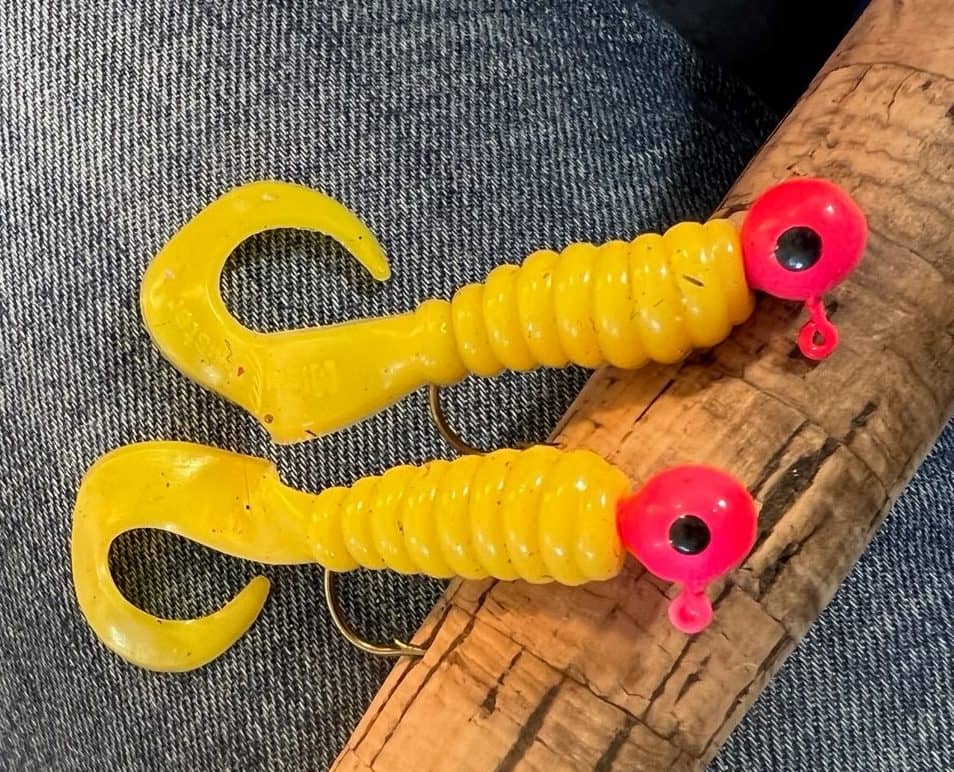
The Upside Down. While a turned up tail on a three-inch grub isn’t an uncommon sight among anglers, there are stranger things to debate when it comes to fishing techniques. Simonson Photo.
By Nick Simonson
In the outdoors, there are always points of contention among anglers, hunters and just about anyone else with an opinion on anything that swims, flies, or falls for a lure or decoy.
I’m not talking about the testifying in front of the legislature type of interactions, or the courtroom conservation battles handled by high priced attorneys in Washington D.C., either. Rather, those greatest of the great debates in the outdoors are the important ones: the best way to rig a plastic, which caliber is the ideal deer gun, and which shotgun shell simply puts down more pheasants.
Like those other great societal arguments that remain in the public court of appeals indefinitely – see generally Ford v. Chevy, Coke v. Pepsi, Vikings v. Packers – how things are done when angling carry with them a similar status. You either set up a presentation or a fishing lure one way or the other, or perhaps even still another, depending on what options are available. In the end it may be there is no right or wrong way to do it, but it sure makes it fun to figure out who’s right and who’s wrong by the end of the trip; or goodness forbid, in our era of ultra-polarization on everything, you try both sides for yourself and perhaps even change your own mind.
Riding the Curl
Split nearly evenly down the middle, between videos online, tackle catalogs, and fishing magazines, is the divisive way in which curly tailed grubs are rigged on a jig hook. I have always – always – rigged the offering with the tail curling down, along the bend of the hook. In fact, being hemmed into my small boat with a number of friends and fishing colleagues who did the same, I was not exposed to the blasphemous way of rigging such a bait with the tail curling up from the hook shank until the expansion of the internet and its myriad how-to presentations.
Sure enough though, I see the up-turned tail on the rods of about half of the jig anglers I encounter, and I get to wondering how they do. Perhaps one day when my setup isn’t catching fish, I’ll switch things around and find out.
Nay to Spray
There are so many fishing gimmicks out there – scent sprays, worm inflaters, Alex Langer’s Flying Lure, sound machines that mimic feeding fish – that it seems some tackle companies aren’t even trying to disguise the fact that they’re trying to hook anglers, rather than help them hook fish. Nevertheless, the additive displays at any sporting goods store are always half full, which means they’re also half empty and a lot of folks are buying those little spray bottles filled with something. Worm juice? Shad oil? Leftover doe pee from last year’s run of Tink’s 69? Who knows?
Sure, as a younger angler, I had the rusty brown juice leak all over my tacklebox from one such bottle. It never caught me any more fish on the oil-soaked plastics, and I can’t recall if it did even when sprayed directly. Perhaps it does for others, but I’m a non-additive guy, content with the action of my lure, or the natural presentation of bait getting the job done.
Hold Still
Normally I’m pro tech, but not so far in this debate; and the nice thing about technology is that in the outdoors, you have the option to use it. You can leave all the gadgets and gear behind one day, and stare only at the water to find your fix of peace and the next day troll a breakline pre-programmed into a console monitor bigger than your Monday morning workstation’s computer screen. In addition to that, all my friends have some sort of spot-lock mechanism on their trolling motors of various brands rigged through their sonars and running right up to a little wireless control hanging around their neck. I still have the old foot-pedal trolling motor on both my boats, and an anchor when I want to hold still.
It’s not that I’m against it, I just haven’t found the need to upgrade. While spot lock sounds great, I keep hearing the same thing on most outings, “wind’s blowing us off our spot lock” or “I don’t think the GPS is connecting to spot lock” or, in PG terms, “gosh darn this cruddy spot lock!” Seems to me, in most situations, the old black anchor still does a pretty good job of holding position.
These are just a sampling of the debates pertaining to angling. Open up the world of discussion to hunting and rifles, shotguns, bows, ammo, even the targets one uses to sight in on, and it’s a raging cacophony of opinions, ideas, and mindsets; many of which may never be changed, and that’s okay.
Like the technology mentioned earlier, we always have the option of exploring one way to do it or another, and the choice to just keep doing it the way we’ve always done and talking about how things worked out after each adventure…in our outdoors.
